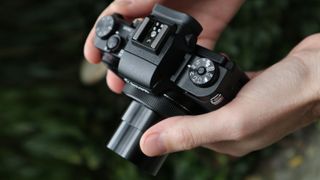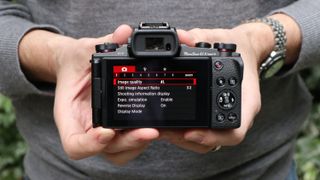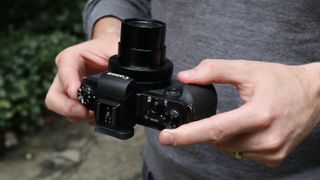OUR EARLY VERDICT
The PowerShot G1 X Mark III is the first APS-C format compact camera to feature a zoom lens, making it something quite unique. It's pricey, but Canon may just have hit the sweet spot for the enthusiast photographer.
FOR
- APS-C sensor in a small body
- Built-in EVF
- Refined touchscreen interface
- Compact size
AGAINST
- Limited zoom range
- Battery life restrictive
- Only 1080p video capture
The Canon PowerShot G1 X Mark III is the latest in a long line of enthusiast-focused compact cameras, designed for photographers looking for something to complement their DSLR, or for those looking for a versatile alternative to a DSLR in a relatively compact body.
The original PowerShot G1 was launched in 2000, and for a while that camera and its successors were the obvious choice when it came to choosing an enthusiast compact.
But with rivals like the RX100 series from Sony, the LX range from Panasonic and Fujifilm's X100 line, Canon's flagship PowerShot compact has struggled to stand out from the crowd in recent years. And it would be fair to say that the outgoing G1 X Mark II, with its unique 1.5-inch sensor, missed the mark, so Canon is chucking everything at the G1 X Mark III.
Features
- APS-C CMOS Sensor, 24.2MP
- 3.0-inch vari-angle touchscreen, 1,040,000 dots
- 1080p video capture
Where the G1 X Mark II used a 1.5-inch sensor, the G1 X Mark III uses a 24.2MP APS-C CMOS chip that's some 36% larger; it's nearly identical to the one in Canon's EOS 80D DSLR, delivering an ISO range from 100 to 25,600.
This is hooked up to Canon's latest DIGIC 7 image processor, allowing the PowerShot G1 X Mark III to not only handle data that much quicker than the older model, but promising to reduce the need to edit images thanks to an Auto Lighting Optimizer and Diffraction Correction.
The G1 X Mark III sports a slightly more modest zoom range than the older model, at 24-72mm compared to 24-120mm, and has a f/2.8-5.6 aperture range. It also offers a close-focusing distance of just 10cm, while the lens features a nine-bladed aperture, which Canon says will produce pleasing background blur.
To minimize blur caused by camera shake, the PowerShot G1 X Mark III features a dual-sensing image stabilization system that can compensate for movement by up to four stops.
There's also five-axis Advanced Dynamic IS for video recording. While we're touching on video, the PowerShot G1 X Mark III can shoot 1080p video at up to 60p – there's no 4K video capture here.
The PowerShot G1 X Mark III features a built-in EVF – something that was missing from the Mark II – with a 2.36 million dot 0.39x Organic EL display, while there's a 3.0-inch vari-angle touchscreen display with a resolution of 1.04 million dots, identical to those on the latest EOS DSLRs, such as the EOS Rebel T7i / 800D.
There's Wi-Fi, NFC and always-on Bluetooth connectivity to enable you to remotely transfer images from your camera to a compatible smart device. Canon's Camera Connect app also lets you wake the camera from its slumber (provided you haven't turned the camera fully off), as well as browse photos and operate the camera remotely.
Build and handling
- 14.8mm thinner and 16% smaller than G1 X Mark II
- Similar weather protection to EOS 80D
- Weighs 399g
The design of the Canon PowerShot G1 X Mark III is quite a shift from the Mark II, more closely resembling that of the PowerShot G5 X, and it's all the better for it.
The G1 X Mark II never felt that satisfying to hold, and felt unnecessarily cumbersome. The Mark III feels much better in the hand – despite squeezing in a larger sensor the camera is some 16% smaller and 14.8mm thinner, while the fit and finish are a noticeable improvement over the older model. The PowerShot G1 X Mark III is even dust- and drip-proof, with Canon stating that it offers similar weather sealing to the EOS 80D.
The PowerShot G1 X Mark III is in actual fact only a bit bigger than the G5 X
The PowerShot G1 X Mark III is in actual fact only a bit bigger than the G5 X, but despite its diminutive proportions it still provides a secure purchase thanks to the sculptured front grip and pronounced thumb rest.
Controls are sensibly positioned, with the front command dial and top plate exposure compensation dial falling under the fingers nicely, while Canon has designed the shutter release to match those of high-end EOS cameras. There's now a single click-less control ring round the front of the lens as well, which can be assigned to functions such as manual focusing, or be used to zoom the lens, though we found rocker switch quicker to use for the latter.
Autofocus
- Dual Pixel CMOS AF
- Touch-and-drag AF
- 49 AF points on a 7 x 7 grid
Canon's Dual Pixel CMOS AF has impressed us for Live View photography on its latest range of EOS DSLRs, so it's no surprise to see it make an appearance in the PowerShot G1 X Mark III.
Featuring 49 AF points arranged in a 7 x 7 grid, the system provides good coverage across the frame, although not quite edge to edge. Focusing is swift, with Canon stating 0.09 secs to acquire focus, while there's also the ability to touch and drag the AF area via the rear screen (even when using the EVF).
Performance
- 7fps burst shooting (9fps with focus lock)
- Polished interface
- 200-shot battery life
The Canon PowerShot G1 X Mark III can shoot at a pretty rapid 7fps, while if you need even more speed you have the option of shooting at 9fps, provided you're prepared to have focus locked at the first shot.
Buffer performance is also pretty respectable, with the camera capable of capturing 24 JPEGs or 19 raw files before it slows up – that's nothing like the blistering performance of Sony's RX100 V, but it should satisfy most potential users.
In the brief time we had with the PowerShot G1 X Mark III, our first impressions were very good. The viewfinder is nice and crisp, while the touchscreen interface has to be one of the best around – it's easy to use, and really responsive.
Battery life is pretty limited, however, at just 200 shots – you'll definitely want to consider additional batteries if you're going to be out for the day or weekend.
Image quality
- ISO100-25,600
- Panoramic shot mode
- +/-3 EV exposure compensation in 1/3 or 1/2-stop increments
We had a chance to shoot with the pre-production model, and while we'll have to wait until we get hold of our full review sample to report in greater deal, we were impressed here too.
With the G1 X Mark III using a sensor that's almost identical to the EOS 80D's, there are no nasty surprises when it comes to image quality. Detail rendition appears very good, while noise is also handled well.

Straight out of camera JPEG file at ISO5000
Early verdict
The Canon PowerShot G1 X Mark III is certainly a big improvement over the undercooked G1 X Mark II. The fact that Canon has managed to engineer a camera this size with a large APS-C sensor is very impressive – and even more impressive is the fact that this is the first APS-C format compact camera to feature a zoom lens, making it something quite unique.
The sticking point might be the $1,299/£1,149 asking price (Australian pricing is yet to be announced), especially when you compare this camera to DSLR or mirrorless rivals. However, if you're set on a premium all-in-one compact camera,the G1 X Mark III doesn't look that bad when you compare it to similarly priced rivals. The fabulous Fujifilm X100F costs more, but doesn't offer a zoom lens, while the slightly more affordable Sony RX100 V offers a longer zoom and snappier performance, but with a smaller 1-inch sensor.
All things considered, Canon may have hit the sweet spot for enthusiast photographers with the PowerShot G1 X Mark III – we'll update this hands-on review with our full and final verdict once we've reviewed it in depth.















